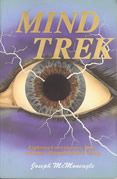|
Mind Trek is Joseph McMoneagle's first book on the remote viewing phenomenon, and it is without doubt a perfect starter book for those who want to know why so many people are talking about the subject these days. Mr. McMoneagle offers the reader a generous perspective into his own personal life in this book, and it is from this perspective that he explains how he became involved with remote viewing. His "path" began in the United States Army. While stationed in Germany in 1970, he experienced what is commonly called a "near death experience," or simply an NDE. It was this experience that gave him his first glimpse into a realm of consciousness that seemed to expand well beyond a normal waking state. In the now classic NDE setting, he saw his body from an outside perspective, perceived what one might consider a telepathic awareness from another nonphysical being, and eventually was forced to relocate himself back into his body which lay "dead" in a hospital. This NDE was clearly the motivating force behind Mr. McMoneagle's subsequent search for a better understanding of consciousness. The experience was as shocking for him as it would be for most people, and his desire to explain it to others led him to the inevitable consequence of confronting a highly skeptical world with a personal experience that was not easily explainable within any of the acceptable scientific paradigms. Moreover, his NDE left him with residual psychic after-effects that were apparently almost as troubling to him as the NDE itself. The entirety of Mr. McMoneagle's description of his journey is filled with riveting depictions of his emotional trauma, and this serves as a vehicle that enables the reader to sympathize with his drive to make sense of his experiences. Mr. McMoneagle's quest to understand both himself and what happened to him eventually led him to work with parapsychologists Russell Targ, Dr. Harold Puthoff, and Dr. Edward May at Stanford Research Institute, now SRI International. It was here that he was formally introduced to the then nascent field of remote viewing. It was a world filled with laboratory experiments, elaborate scientific controls, and most important of all, keen minds that approached the idea of investigating psychic phemonena without the kneejerk prejudice of impossible- to-convince skeptics. What is so enriching about these experiences of Mr. McMoneagle is how well he took to the laboratory environment. It is here that he thrived as a participant in a large number of experiments that probed the known limits of psychic perception at a distance. He shares these experiences with his readers by effectively exploiting the clarity which is characteristic of his writing to convey his growing sense of wonder. A common misperception of many people with regard to psychic phemonena is that psychic experiences should be as clear as those obtained with the physical senses. Mr. McMoneagle offers an exceptionally clear description of both how and why psychic perceptions differ from perceptions made by the five senses of hearing, touch, sight, taste, and smell. Readers will expecially enjoy his detailed descriptions of his own psychic perceptions as they were made within the laboratory environment, as well as the descriptions of the laboratory environment itself. In the remote-viewing world, places and things that a person is supposed to psychically perceive are called "targets." More often than not, Mr. McMoneagle's targets are locations that are rich in unique characteristics and design, and his descriptions of those targets are generally intrigingly accurate. One of his methods of description is to use transcripts of remote viewing sessions in which he is verbally describing a target. This method of exposition helps to convey to his readers some of the real-time excitement that must have been a visceral part of these early remote viewing experiments. Most of the targets described by Mr. McMoneagle are of a sort known as "verifiable," which means that the targets are of well-known places for which there are detailed photographs. But Mr. McMoneagle does not close the door on more far-flung targets entirely. In one of the most intriquing sessions, this one conducted in research conducted at The Monroe Institute in Faber, Virginia, Mr. McMoneagle describes what appears to be an ancient (and dying) civilization on Mars. Rather than try to force the reader to accept these perceptions as real and accurate, he leaves it up to the reader to decide how to respond. Since the description of this target occurs near the end of a book in which the reality of the remote viewing phenomenon is so strikingly portrayed, Mr. McMoneagle's description of a long-lost Martian setting acts to keep the reader at the edge of his or her seat, begging for more. Fortunately for all of us, there is more, as Mr. McMoneagle has matured into a somewhat prolific and talented author. If readers like Mind Trek, they will want to read the rest of his books as well.
|

